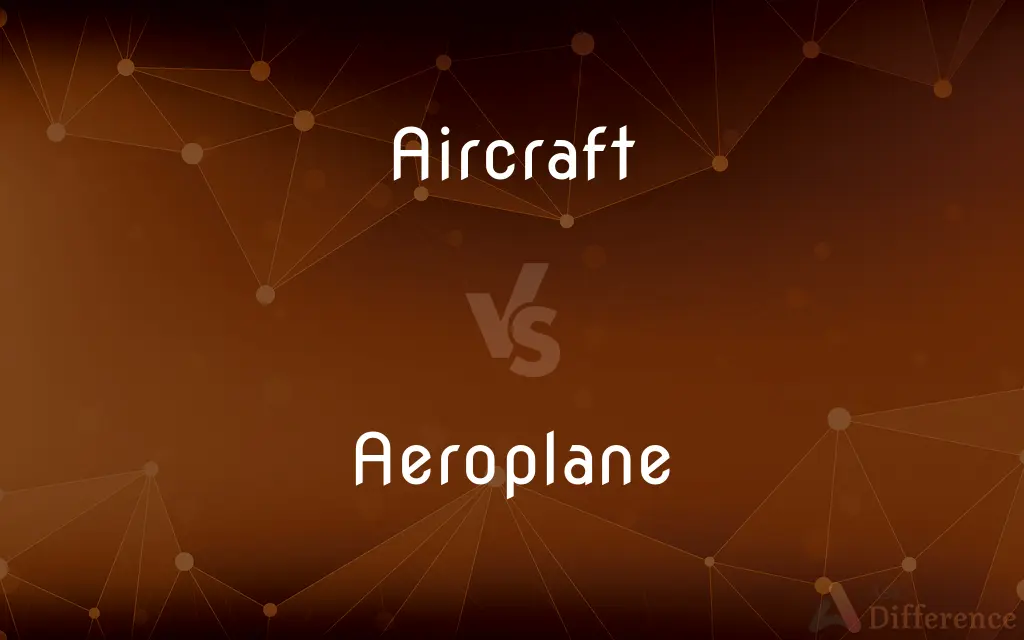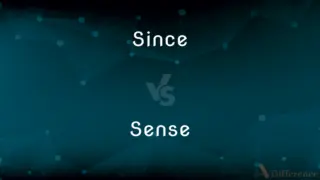Aircraft vs. Aeroplane — What's the Difference?
Edited by Tayyaba Rehman — By Fiza Rafique — Updated on September 25, 2023
An "aircraft" is any vehicle capable of flight. An "aeroplane" (or "airplane" in American English) is a fixed-wing aircraft powered by engines. All aeroplanes are aircraft, but not all aircraft are aeroplanes.

Difference Between Aircraft and Aeroplane
Table of Contents
ADVERTISEMENT
Key Differences
The term "aircraft" serves as a broad category that encompasses any machine or vehicle that can fly or navigate in the air. This includes helicopters, drones, balloons, and gliders. On the other hand, "aeroplane" refers specifically to a type of aircraft that has fixed wings and is primarily powered by one or more jet engines or propellers.
Taking an example, if we look at a helicopter and a Boeing 747, both are considered "aircraft" because they both can navigate and operate in the air. However, only the Boeing 747 is an "aeroplane" because it possesses fixed wings and is powered by jet engines. The helicopter, although an aircraft, is not an aeroplane.
Regional differences also play a role. In American English, the term "airplane" is more commonly used than "aeroplane." However, both terms mean the same and are interchangeable when discussing fixed-wing aircraft. Regardless of the region, the term "aircraft" remains an umbrella term encompassing all flying vehicles.
Comparison Chart
Definition
Any vehicle capable of flight.
A fixed-wing aircraft powered by engines.
Includes
Helicopters, drones, balloons, gliders, aeroplanes.
Only fixed-wing machines.
ADVERTISEMENT
Engines
May or may not have engines.
Typically has one or more engines.
Regional Variation (U.S.)
Used universally.
"Airplane" is preferred over "aeroplane".
Scope
Includes both manned and unmanned flying vehicles.
Usually implies larger, manned vehicles.
Compare with Definitions
Aircraft
Can be either manned or unmanned.
Drones are small unmanned aircraft used for various purposes.
Aeroplane
Commonly used for commercial travel and transportation.
The aeroplane carried passengers from New York to London.
Aircraft
Any machine or vehicle that can navigate the air.
The museum has a vast collection of historic aircraft.
Aeroplane
Utilizes propulsion, usually from jet engines or propellers, for flight.
The roar of the aeroplane's engines filled the air.
Aircraft
A broad category including aeroplanes, helicopters, and more.
Modern aircraft have advanced navigation systems.
Aeroplane
Can vary in size from small personal craft to large commercial jets.
That's a model of the first aeroplane flown by the Wright brothers.
Aircraft
Classified based on their method of lift, propulsion, and structure.
The stealth bomber is a specialized military aircraft.
Aeroplane
A fixed-wing aircraft powered by engines.
The aeroplane soared gracefully into the sky.
Aircraft
Requires a certain infrastructure for operation like runways, helipads, or launch systems.
The city's airport can accommodate large aircraft.
Aeroplane
Distinct from helicopters due to its fixed-wing structure.
Unlike helicopters, an aeroplane needs a runway for takeoff.
Aircraft
An aircraft is a vehicle or machine that is able to fly by gaining support from the air. It counters the force of gravity by using either static lift or by using the dynamic lift of an airfoil, or in a few cases the downward thrust from jet engines.
Aeroplane
A powered flying vehicle with fixed wings and a weight greater than that of the air it displaces.
Aircraft
An aeroplane, helicopter, or other machine capable of flight.
Aeroplane
Variant of airplane.
Aircraft
A machine or device, such as an airplane, helicopter, glider, dirigible, or drone, capable of atmospheric flight.
Aeroplane
A powered heavier-than-air aircraft with fixed wings.
Aircraft
A vehicle capable of atmospheric flight due to interaction with the air, such as buoyancy or lift
Aeroplane
An airfoil.
Aircraft
Any vehicle, such as an airplane, helicopter, balloon, etc., for floating in, or flying through, the air.
Aeroplane
Any of various nymphalid butterflies, of various genera, having a slow gliding flight. Also called planes.
Aircraft
A vehicle that can fly
Aeroplane
(intransitive) To fly in an aeroplane.
Aeroplane
(transitive) To transport by aeroplane.
Aeroplane
A light rigid plane used in aërial navigation to oppose sudden upward or downward movement in the air, as in gliding machines; specif., such a plane slightly inclined and driven forward as a lifting device in some flying machines. Also called airfoil.
Aeroplane
Hence, a heavier-than-air flying machine using such a device to provide lift. In a modern aeroplane, the airfoils are called the wings, and most of the lift is derived from these surfaces. In contrast to helicopters, the wings are fixed to the passenger compartment (airframe) and do not move relative to the frame; thus such a machine is called a fixed-wing aircraft. These machines are called monoplanes, biplanes, triplanes, or quadruplanes, according to the number of main supporting planes (wings) used in their construction. After 1940 few planes with more than one airfoil were constructed, and these are used by hobbyists or for special purposes. Being heavier than air they depend for their levitation on motion imparted by the thrust from either propellers driven by an engine, or, in a jet plane, by the reaction from a high-velocity stream of gases expelled rearward from a jet engine. They start from the ground by a run on small wheels or runners, and are guided by a steering apparatus consisting of horizontal and vertical movable planes, which usually form part of the wings or tail. There are many varieties of form and construction, which in some cases are known by the names of their inventors. In U.S., an aeroplane is usually called an airplane or plane.
Aeroplane
An aircraft that has a fixed wing and is powered by propellers or jets;
The flight was delayed due to trouble with the airplane
Common Curiosities
Do all aircraft have engines?
No, while all aeroplanes have engines, not all aircraft, like gliders, do.
Are all aeroplanes considered aircraft?
Yes, all aeroplanes are aircraft, but not all aircraft are aeroplanes.
In American English, is "airplane" more common than "aeroplane"?
Yes, in American English, "airplane" is preferred over "aeroplane."
Can the term "aircraft" refer to military vehicles?
Yes, military vehicles like fighter jets are also classified as aircraft.
What primarily differentiates an aeroplane from other aircraft?
An aeroplane specifically has fixed wings and is powered by engines.
Is a drone an aeroplane or aircraft?
A drone is considered an aircraft but not an aeroplane.
Why is "aircraft" a broader term than "aeroplane"?
"Aircraft" encompasses all air-navigable machines, while "aeroplane" specifies fixed-wing ones.
Can "airplane" and "aeroplane" be used interchangeably?
Generally, yes, though "airplane" is more common in American English.
Can a helicopter be called an aeroplane?
No, a helicopter is an aircraft but not an aeroplane.
Is "aeroplane" used to refer only to commercial passenger planes?
No, "aeroplane" can refer to any fixed-wing aircraft, regardless of its use or size.
Do all aeroplanes require a pilot?
Most aeroplanes require pilots, but there are unmanned aeroplane prototypes in development.
How do gliders differ from aeroplanes?
Gliders are aircraft without engines, relying on currents for flight, while aeroplanes have engines.
Which term, aircraft or aeroplane, includes drones?
Drones are considered aircraft but not aeroplanes.
Are balloons and blimps considered aeroplanes?
No, they are types of aircraft but not aeroplanes.
Are all aeroplanes designed for transportation?
No, aeroplanes serve various purposes, including recreation, military operations, and research.
Share Your Discovery

Previous Comparison
Android vs. Robot
Next Comparison
Since vs. SenseAuthor Spotlight
Written by
Fiza RafiqueFiza Rafique is a skilled content writer at AskDifference.com, where she meticulously refines and enhances written pieces. Drawing from her vast editorial expertise, Fiza ensures clarity, accuracy, and precision in every article. Passionate about language, she continually seeks to elevate the quality of content for readers worldwide.
Edited by
Tayyaba RehmanTayyaba Rehman is a distinguished writer, currently serving as a primary contributor to askdifference.com. As a researcher in semantics and etymology, Tayyaba's passion for the complexity of languages and their distinctions has found a perfect home on the platform. Tayyaba delves into the intricacies of language, distinguishing between commonly confused words and phrases, thereby providing clarity for readers worldwide.















































